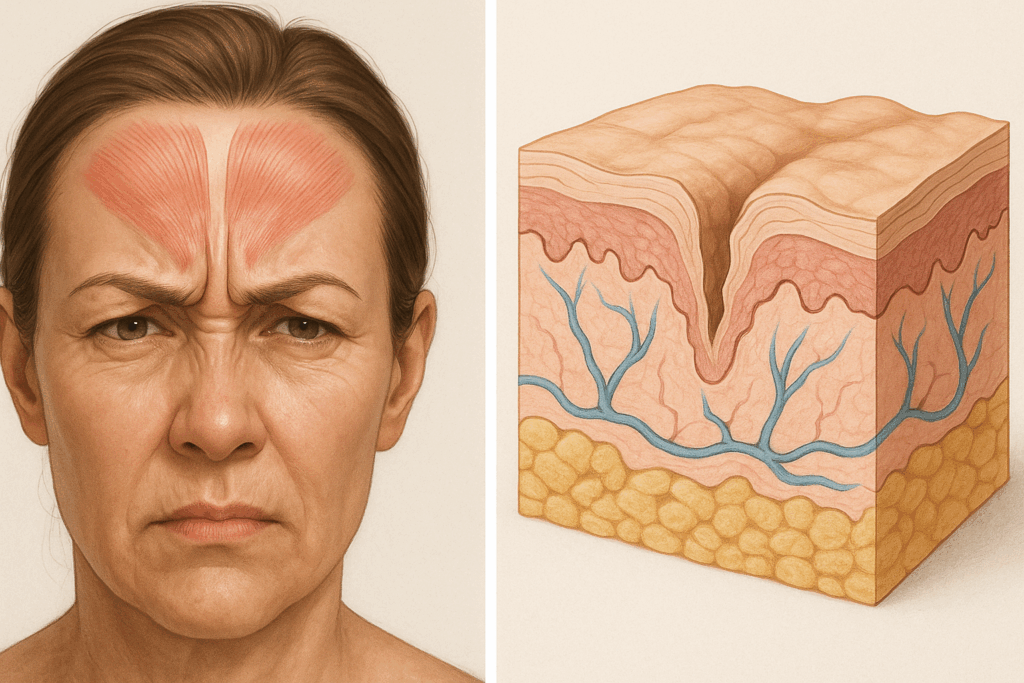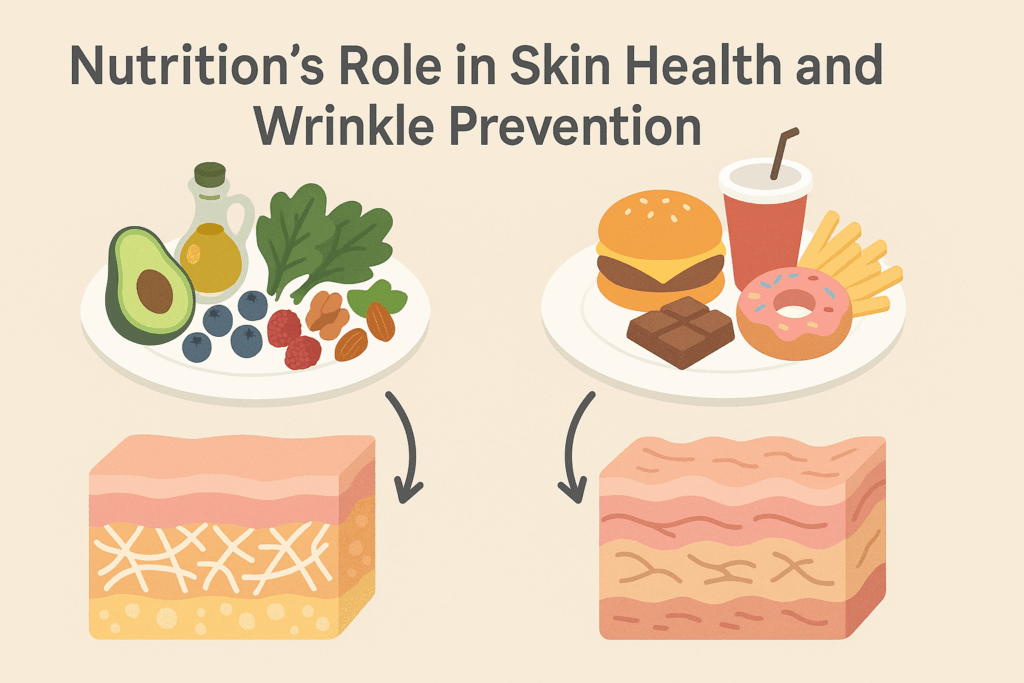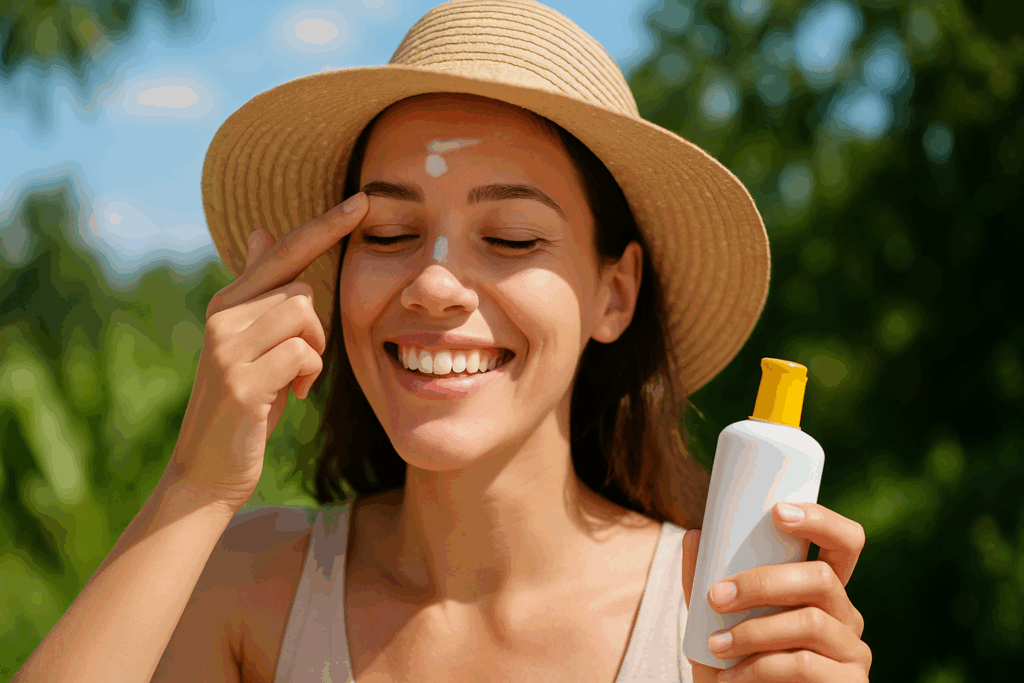Forehead wrinkles are a natural part of aging, but for many, they become a source of concern much earlier than expected. Whether they appear subtly in one’s twenties or deepen with time into visible furrows by age thirty or beyond, these lines can provoke questions about self-image, skin health, and even emotional expression. While the cosmetic industry offers countless solutions ranging from injectable neurotoxins to laser resurfacing, a growing body of evidence and expert consensus now supports the effectiveness of non-invasive, natural methods. Understanding how to get rid of forehead wrinkles naturally not only empowers individuals to take a proactive, holistic approach to skin care but also fosters a deeper appreciation for how our skin reflects internal well-being.
You may also like: How to Choose Skin Care for Fine Lines: Evidence-Based Tips for Healthier, Younger-Looking Skin

Understanding the Origins of Forehead Wrinkles
Forehead lines, also called glabellar lines or horizontal wrinkles, form primarily due to repeated muscular contractions, a decline in skin elasticity, and the cumulative impact of environmental exposures. When we express emotions such as worry or surprise, the frontalis muscle contracts, causing the skin to crease. Over time, these temporary folds can etch into the dermis, creating permanent lines. Other major contributors include photodamage from ultraviolet (UV) radiation, oxidative stress, and a reduction in collagen and elastin synthesis. The question “why do I have wrinkles on my forehead?” is often answered by a combination of genetic predisposition, lifestyle habits, and skincare choices, with each factor playing a dynamic role.
The Natural Aging Process and Forehead Lines
Aging is accompanied by a natural decline in hyaluronic acid, which helps maintain hydration in the skin, as well as collagen, the protein responsible for firmness and structure. As these substances diminish, the skin becomes thinner and less resilient, increasing its susceptibility to fine lines and deeper creases. Deep forehead wrinkles, particularly those that form parallel bands or deep forehead creases, may signal more advanced dermal degradation. While aging is inevitable, how it manifests on the skin can be moderated by lifestyle choices, making the pursuit of how to reduce forehead wrinkles through natural methods not only possible but scientifically supported.

Lifestyle Factors That Accelerate Wrinkle Formation
Among the most overlooked aspects of forehead wrinkle treatment is the impact of chronic lifestyle stressors. Lack of sleep, high cortisol levels, and nutritional deficiencies all impair the skin’s ability to repair and regenerate. Smokers and individuals exposed to environmental toxins often experience an accelerated appearance of wrinkles on the forehead due to impaired microcirculation and free radical damage. Additionally, repeated squinting or frowning, often linked to vision problems or habitual facial expressions, can contribute to the early development of 11 lines—the vertical creases between the brows. Understanding how to prevent forehead wrinkles begins with addressing the internal and behavioral factors that influence skin longevity.
The Science Behind Natural Skincare for Wrinkle Reduction
Recent dermatological research underscores the role of natural antioxidants, phytonutrients, and barrier-supportive skincare in reducing visible signs of aging. For those seeking the best way to get rid of wrinkles on the forehead without synthetic chemicals or invasive procedures, the integration of scientifically validated botanical ingredients is key. Ingredients such as vitamin C, retinol alternatives like bakuchiol, peptides, and plant-derived oils support dermal regeneration while minimizing the risk of irritation. Natural remedies for how to get rid of deep forehead wrinkles are most effective when combined with a broader skincare regimen that emphasizes hydration, sun protection, and collagen support.

Nutrition’s Role in Skin Health and Wrinkle Prevention
Internal nourishment is as critical as topical skincare when seeking to eliminate forehead wrinkles naturally. Diets rich in omega-3 fatty acids, antioxidants such as vitamin E and polyphenols, and protein provide the building blocks for resilient skin. Collagen production relies on adequate intake of vitamin C, zinc, and amino acids such as proline and glycine. Conversely, diets high in sugar and processed foods promote glycation, a process that stiffens collagen fibers and leads to loss of elasticity. For individuals wondering how to avoid forehead wrinkles in the long term, nutritional choices play a foundational role in dermal integrity.
Hydration and Skin Elasticity
One of the simplest yet most powerful tools for minimizing forehead wrinkles is proper hydration. When the skin is well-hydrated, it appears plumper and more elastic, which can soften the appearance of existing lines. Hydration affects both the epidermis and deeper layers of the skin, supporting nutrient transport and cellular turnover. Drinking adequate water daily, alongside the use of humectant-rich moisturizers containing hyaluronic acid or glycerin, offers a twofold benefit in the quest to cure forehead wrinkles. Natural strategies that combine internal hydration with moisture retention techniques are among the best treatments for forehead wrinkles that avoid invasive procedures.

Facial Exercises and Muscle Relaxation Techniques
A relatively under-discussed yet effective approach to how to rid forehead lines involves targeted facial exercises. These exercises work by toning underlying muscles and encouraging lymphatic drainage, which can reduce puffiness and improve skin tone. Relaxation techniques that reduce chronic tension in the forehead—such as progressive muscle relaxation, yoga, and mindfulness practices—also contribute to smoother skin by limiting the repetitive movements that lead to forehead line formation. For those concerned with how to eliminate forehead wrinkles naturally, cultivating mindful facial awareness is a cost-free, evidence-informed approach.
The Power of Sun Protection
Among all environmental factors, UV radiation remains the most significant contributor to premature skin aging. UV exposure accelerates collagen breakdown and leads to uneven pigmentation and texture changes. Daily application of broad-spectrum sunscreen is not merely a cosmetic recommendation but a medical imperative in the prevention and treatment of forehead wrinkles. Mineral-based sunscreens with zinc oxide or titanium dioxide offer excellent protection while minimizing irritation, particularly for individuals with sensitive or acne-prone skin. Understanding how to prevent forehead wrinkles requires acknowledging that daily sun protection is foundational to any successful regimen.
Topical Antioxidants and Their Protective Role
Topical antioxidants have emerged as a central component of non-invasive skin therapy, offering both protective and reparative benefits. Serums rich in vitamin C, resveratrol, niacinamide, and green tea polyphenols help neutralize free radicals and reduce inflammation. These ingredients can enhance the skin’s barrier function, improve elasticity, and reduce oxidative stress, all of which contribute to minimizing the appearance of fine lines on the forehead. Incorporating such formulations into a daily skincare routine supports the broader goal of how to reduce forehead wrinkles with consistent, evidence-based practices.
Adopting Sleep Hygiene and Stress Reduction Practices
Chronic sleep deprivation not only impairs skin barrier repair but also increases systemic inflammation, both of which are linked to accelerated skin aging. Establishing consistent sleep hygiene practices—such as maintaining a regular bedtime, reducing screen exposure before sleep, and ensuring adequate melatonin production—contributes to the body’s natural nighttime repair processes. Coupled with stress-reducing activities like deep breathing, tai chi, and nature immersion, these habits form the backbone of holistic approaches to how to eliminate forehead wrinkles naturally. Reducing sympathetic nervous system dominance can also soften habitual expressions that deepen forehead creases.

Natural Oils and Botanical Extracts
Essential oils and plant-based extracts offer a gentle yet effective pathway for those seeking how to remove forehead wrinkles without synthetic chemicals. Rosehip oil, for example, is rich in vitamin A and essential fatty acids that promote collagen synthesis and skin regeneration. Frankincense and sandalwood oils have traditionally been used to improve skin texture and tone, while argan oil delivers potent hydration. These botanicals, when used appropriately, can enhance skin elasticity and promote a smoother appearance. For those exploring how to get rid of forehead wrinkles naturally, these natural oils can be incorporated into nighttime rituals or layered beneath moisturizers to amplify results.
Understanding the Role of Facial Massage
Manual stimulation through facial massage improves circulation, lymphatic flow, and nutrient delivery to skin tissues. Techniques such as gua sha, acupressure, and manual lymphatic drainage can be particularly effective in reducing facial puffiness and relaxing tension across the brow. Over time, these methods can help reduce the appearance of a forehead line or 11 lines by encouraging muscle relaxation and skin revitalization. As part of a broader forehead wrinkle treatment strategy, facial massage offers both cosmetic and psychological benefits, contributing to overall wellness and skin harmony.

Mind-Body Connection and Skin Health
Scientific interest in the skin-brain axis has revealed intriguing links between emotional well-being and dermal health. Psychological stress not only worsens inflammatory skin conditions but also accelerates the degradation of collagen through elevated cortisol levels. Practices that enhance emotional regulation—such as journaling, meditation, or cognitive behavioral therapy—can thus indirectly support skin regeneration. For those navigating how to minimize forehead wrinkles in a holistic manner, addressing the mental-emotional terrain is an often-overlooked yet essential step.
Herbal Remedies and Natural Supplements
Certain adaptogenic herbs and natural supplements have been shown to support skin health from within. Ashwagandha, for instance, can reduce cortisol levels and improve the body’s resilience to stress, while gotu kola has been linked to improved collagen production and wound healing. Marine collagen supplements and hyaluronic acid capsules have also demonstrated efficacy in clinical trials for enhancing skin moisture and reducing wrinkles. When integrated into a comprehensive strategy for how to get rid of forehead wrinkles naturally, these internal supports can act synergistically with topical treatments and lifestyle modifications.

Early Prevention: Addressing Forehead Wrinkles at 20 or 30
For younger individuals noticing forehead wrinkles at 20 or forehead wrinkles at 30, the message is not one of alarm but of opportunity. Early signs of fine lines offer a chance to adopt preventive measures before these lines deepen into permanent creases. At this stage, consistent sun protection, basic hydration, and stress management can yield significant long-term benefits. Developing facial awareness and minimizing unconscious frowning or squinting also helps limit the development of 11 lines and forehead lines. Understanding how to avoid forehead wrinkles early on is a key investment in lifelong skin health and self-confidence.
What Works and What Doesn’t: Avoiding Common Pitfalls
Not all natural remedies are equally effective, and some well-intentioned habits may even backfire. For example, excessive facial exercises done with poor technique can exacerbate wrinkles rather than improve them. Similarly, applying highly acidic substances or abrasive scrubs can disrupt the skin barrier and trigger inflammation. When seeking the best thing for forehead wrinkles, it is important to rely on expert-reviewed protocols and peer-reviewed research rather than viral trends. The best way to remove forehead wrinkles will always involve evidence-based interventions that prioritize both skin integrity and overall well-being.
The Limitations and Realistic Expectations of Natural Methods
While natural strategies offer powerful tools for skin rejuvenation, it is essential to set realistic expectations. Deep forehead wrinkles may soften, but they may not disappear entirely without clinical intervention. Nevertheless, natural approaches offer cumulative benefits that extend beyond aesthetics, including improved hydration, emotional balance, and reduced inflammation. For individuals seeking how to get rid of 11 lines naturally, patience, consistency, and a multifaceted approach are key. Even the best procedure for forehead wrinkles cannot replace the long-term benefits of daily care rooted in sustainable lifestyle choices.
Integrating Natural Skincare Into a Lifelong Wellness Strategy
Ultimately, the pursuit of smoother, healthier skin is not merely cosmetic—it reflects a broader commitment to self-care, prevention, and mindful living. Whether driven by a desire to reduce fine lines on the forehead or to eliminate forehead wrinkles naturally, this journey can become a gateway to deeper awareness of the body’s needs. As individuals seek the best treatment for 11 lines or explore how to eliminate forehead wrinkles naturally, they often discover that beauty and wellness are inseparable. Skin health, like mental health, thrives in environments of nourishment, consistency, and care.
Frequently Asked Questions: How to Get Rid of Forehead Wrinkles Naturally
1. Are forehead wrinkles at 20 a sign of premature aging, or can they be completely normal?
Forehead wrinkles at 20 often raise concerns about premature aging, but they aren’t always a cause for alarm. These lines can be the result of expressive facial habits, like frequent eyebrow raising or frowning, and not necessarily a sign of dermal degeneration. Genetics, dehydration, and unprotected sun exposure during adolescence can also accelerate their appearance. While they may be an early cosmetic concern, these lines can be minimized through consistent hydration, facial awareness training, and the strategic use of natural ingredients like bakuchiol. Understanding how to get rid of forehead wrinkles naturally at an early age involves correcting lifestyle patterns as much as applying topical products.
2. What role does facial posture play in developing deep forehead creases?
Facial posture—the way we unconsciously hold tension in our facial muscles—plays a surprisingly large role in the development of deep forehead creases. Many people habitually furrow their brows while concentrating or squinting, leading to repetitive stress on the skin. Over time, this can deepen forehead lines and contribute to the visibility of 11 lines. Becoming aware of these patterns, especially during screen time or stressful moments, is a critical first step in forehead wrinkle treatment. In fact, one of the most underrated methods for how to prevent forehead wrinkles is through conscious facial relaxation techniques and vision correction when needed.
3. Can digital device use contribute to fine lines on the forehead?
Yes, extended use of digital devices can indirectly lead to the formation of fine lines on the forehead. This happens due to prolonged squinting at screens, poor lighting conditions, and increased eye strain, which causes the brow muscles to contract more frequently. Such repetitive micro-movements contribute to the formation of both horizontal forehead lines and vertical 11 lines. Learning how to rid forehead lines may involve optimizing screen ergonomics, taking regular breaks, and using blue light filters or glasses. Small ergonomic adjustments can significantly reduce the muscular strain that leads to wrinkles on the forehead over time.
4. Are there any specific natural supplements that help reduce forehead wrinkles from within?
Yes, certain natural supplements have shown promise in supporting skin structure and helping reduce forehead wrinkles internally. Marine collagen peptides, when hydrolyzed for better absorption, have been associated with improved skin elasticity and hydration. Additionally, astaxanthin—a potent antioxidant derived from microalgae—may help reduce oxidative stress in skin cells, a known contributor to forehead line formation. Supplements containing hyaluronic acid, vitamin C, and silica may also support how to eliminate forehead wrinkles naturally by boosting collagen synthesis and skin moisture levels. These internal strategies complement topical care and offer a more comprehensive approach to wrinkle prevention.
5. How do emotions and facial expressions influence the depth of forehead lines over time?
Emotional expression, while vital to human communication, often leaves a lasting mark on our skin—particularly the forehead. Habitual expressions like worry, surprise, or skepticism cause micro-contractions in the frontalis and corrugator muscles, leading to pronounced forehead lines over time. The emotional brain doesn’t distinguish between a real threat and chronic stress, so even internalized anxiety can subtly influence facial tension. Long-term emotional regulation practices such as breathwork, mindfulness, or expressive writing can reduce this habitual muscle tension. For those wondering how to reduce forehead wrinkles naturally, managing facial expressivity with awareness becomes an important—yet often ignored—tool.
6. Is it possible to cure forehead wrinkles without any cosmetic procedures?
While “cure” is a strong word, it is absolutely possible to significantly diminish the appearance of forehead wrinkles using non-invasive methods. Those wondering how to get rid of forehead wrinkles naturally can achieve visible improvements through consistent skin hydration, facial massage, antioxidant-rich skincare, and internal nutritional support. The best way to remove forehead wrinkles without medical intervention is through a layered approach that treats the skin both topically and systemically. While deep forehead wrinkles may not vanish entirely, their depth, texture, and prominence can be reduced substantially with time and discipline. Realistic expectations combined with dedicated care can produce long-term, sustainable results.
7. Why do some people get forehead wrinkles at 30 while others don’t show them until much later?
The appearance of forehead wrinkles at 30 often comes down to a mix of genetics, lifestyle, and environmental exposure. People with naturally thinner or drier skin are more prone to fine lines earlier, especially if their skincare routine lacks UV protection or antioxidants. Others may have spent more time outdoors without sunscreen or experienced high levels of chronic stress. Meanwhile, someone who maintains strong hydration, consistent sleep, and uses preventive skincare may avoid visible wrinkles on the forehead until much later in life. Understanding how to prevent forehead wrinkles starts with recognizing and mitigating the unique risk factors in your lifestyle and skin biology.
8. What is the best way to get rid of 11 lines without injections?
The best treatment for 11 lines naturally focuses on softening the underlying muscle tension and restoring skin elasticity through consistent, integrative care. This includes applying peptides, using gua sha massage to improve circulation, and introducing facial yoga to relax the glabellar area. Topical treatments rich in botanical retinoid alternatives can stimulate collagen in the skin between the brows. Additionally, biofeedback tools and mirror-based exercises can help retrain the brow muscles to stay relaxed during emotional or focused tasks. For those seeking how to get rid of 11 lines naturally, combining muscle re-education with regenerative skincare yields the most visible results over time.
9. How long does it usually take to see results from natural forehead wrinkle treatment methods?
Results from natural approaches to forehead wrinkle treatment tend to be gradual but accumulative. Depending on the depth of the wrinkles and the consistency of your regimen, noticeable changes can be observed within 6 to 12 weeks. Those practicing facial massage, topical antioxidant use, and dietary changes often report smoother skin texture and improved elasticity within the first month. However, deeper forehead wrinkles may require longer timelines and may never fully disappear without clinical intervention. That said, how to eliminate forehead wrinkles naturally depends greatly on individual skin type, the severity of existing lines, and overall lifestyle balance.
10. Are there any long-term psychological benefits to learning how to avoid forehead wrinkles naturally?
Yes, there can be profound psychological benefits to embracing natural methods for skin aging, including increased self-efficacy, mindfulness, and reduced appearance anxiety. Engaging in daily rituals aimed at how to avoid forehead wrinkles encourages intentionality and body awareness, which are both linked to improved emotional well-being. Rather than relying on quick fixes, this approach fosters a sense of control and continuity over the aging process. Furthermore, learning how to get rid of forehead wrinkles naturally reinforces self-care behaviors that extend beyond aesthetics, supporting overall mental health and resilience. This internal shift can often have more lasting value than any external cosmetic change.
A Holistic Takeaway: How to Get Rid of Forehead Wrinkles Naturally and Sustainably
In the end, addressing forehead lines is not about chasing impossible ideals or fearing the signs of aging. It is about responding with intelligence, compassion, and intention. For those who ask, “why do I have lines on my forehead?” the answer often lies not only in muscle movement or sun exposure but also in how we treat our bodies, manage stress, and prioritize skin health. From understanding how to get rid of forehead wrinkles naturally to embracing the best way to remove forehead wrinkles through integrative care, this journey reflects the best of what evidence-based, person-centered wellness can offer. By aligning external skincare with internal health, we not only soften wrinkles but also foster resilience, confidence, and well-being that lasts far beyond the mirror.
Was this article helpful? Don’t let it stop with you. Share it right now with someone who needs to see it—whether it’s a friend, a colleague, or your whole network. And if staying ahead on this topic matters to you, subscribe to this publication for the most up-to-date information. You’ll get the latest insights delivered straight to you—no searching, no missing out
Further Reading:
How to Get Rid of Wrinkles: 10 Natural Treatments
How to Get Rid of Forehead Wrinkles, According to Derms
How to Eliminate Forehead Wrinkles: Proven Tips
Disclaimer
The information contained in this article is provided for general informational purposes only and is not intended to serve as medical, legal, or professional advice. While Health11News strives to present accurate, up-to-date, and reliable content, no warranty or guarantee, expressed or implied, is made regarding the completeness, accuracy, or adequacy of the information provided. Readers are strongly advised to seek the guidance of a qualified healthcare provider or other relevant professionals before acting on any information contained in this article. Health11News, its authors, editors, and contributors expressly disclaim any liability for any damages, losses, or consequences arising directly or indirectly from the use, interpretation, or reliance on any information presented herein. The views and opinions expressed in this article are those of the author(s) and do not necessarily reflect the official policies or positions of Health11News.